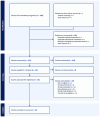The Safety of the Laryngeal Mask Airway in Adenotonsillectomy: A Systematic Review and Meta-Analysis
- PMID: 38899617
- PMCID: PMC11191617
- DOI: 10.1177/19160216241263851
The Safety of the Laryngeal Mask Airway in Adenotonsillectomy: A Systematic Review and Meta-Analysis
Abstract
Background: Adenotonsillectomy is one of the most common surgical procedures worldwide. The current standard for securing the airway in patients undergoing adenotonsillectomy is endotracheal tube (ETT) intubation. Several studies have investigated the use of the laryngeal mask airway (LMA) in this procedure. We conducted a systematic review and meta-analysis to compare the safety and efficacy of the LMA versus ETT in adenotonsillectomy.
Method: Databases were searched from inception to 2022 for randomized controlled trials and comparative studies. Preferred Reporting Items for Systematic Reviews and Meta-Analyses (PRISMA) guidelines were followed. The primary outcome is the rate of perioperative respiratory adverse events (PRAEs). Secondary outcomes included the rate of conversion to ETT, desaturations, nausea/vomiting, and surgical time. A subgroup analysis, risk of bias, publication bias, and Grading of Recommendations Assessment, Development, and Evaluation (GRADE) assessments were also performed.
Results: Twelve studies were included in the analysis (4176 patients). The mean overall conversion to ETT was 8.36% [95% confidence interval (CI) = 8.17, 8.54], and for the pediatric group 8.27% (95% CI = 8.08, 8.47). The mean rate of conversion to ETT secondary to complications was 2.89% (95% CI = 2.76, 3.03) while the rest was from poor surgical access. Overall, there was no significant difference in PRAEs [odds ratio (OR) 1.16, 95% CI = 0.60, 2.22], desaturations (OR 0.79, 95% CI = 0.38, 1.64), or minor complications (OR 0.89, 95% CI = 0.50, 1.55). The use of LMA yielded significantly shorter operative time (mean difference -4.38 minutes, 95% CI = -8.28, -0.49) and emergence time (mean difference -4.15 minutes, 95% CI = -5.63, -2.67).
Conclusion: For adenotonsillectomy surgery, LMA is a safe alternative to ETT and requires less operative time. Careful patient selection and judgment of the surgeon and anesthesiologist are necessary, especially given the 8% conversion to ETT rate.
Keywords: LMA; adenotonsillectomy; airway management; endotracheal tube; laryngeal mask airway; meta-analysis; pediatric adenotonsillectomy; pediatric anesthesia; postoperative outcomes; systematic review.
Conflict of interest statement
Declaration of Conflicting InterestsThe author(s) declared no potential conflicts of interest with respect to the research, authorship, and/or publication of this article.
Figures



Similar articles
-
The laryngeal mask airway for pediatric adenotonsillectomy: predictors of failure and complications.Int J Pediatr Otorhinolaryngol. 2013 Jan;77(1):25-8. doi: 10.1016/j.ijporl.2012.09.021. Epub 2012 Oct 11. Int J Pediatr Otorhinolaryngol. 2013. PMID: 23063385
-
Laryngeal mask airway versus endotracheal tube in pediatric adenotonsillectomy.Laryngoscope. 2012 Feb;122(2):429-35. doi: 10.1002/lary.22458. Epub 2012 Jan 17. Laryngoscope. 2012. PMID: 22252780 Clinical Trial.
-
The use of laryngeal mask airway for adenoidectomy.Int J Pediatr Otorhinolaryngol. 2018 Apr;107:42-44. doi: 10.1016/j.ijporl.2018.01.034. Epub 2018 Jan 31. Int J Pediatr Otorhinolaryngol. 2018. PMID: 29501309
-
Laryngeal Mask Airway Versus Other Airway Devices for Anesthesia in Children With an Upper Respiratory Tract Infection: A Systematic Review and Meta-analysis of Respiratory Complications.Anesth Analg. 2018 Oct;127(4):941-950. doi: 10.1213/ANE.0000000000003674. Anesth Analg. 2018. PMID: 30059398
-
Laryngeal mask airway versus endotracheal tube for percutaneous dilatational tracheostomy in critically ill adults.Cochrane Database Syst Rev. 2018 Nov 15;11(11):CD009901. doi: 10.1002/14651858.CD009901.pub3. Cochrane Database Syst Rev. 2018. PMID: 30536850 Free PMC article. Review.
Cited by
-
Hyomental distance measured ultrasonography versus weight-based criteria for laryngeal mask size selection in children: a randomized controlled trial.BMC Anesthesiol. 2025 Aug 25;25(1):419. doi: 10.1186/s12871-025-03303-8. BMC Anesthesiol. 2025. PMID: 40855263 Free PMC article.
-
Alterations of Gut Microbiome Composition and Function Pre- and Post-Adenotonsillectomy in Children with Obstructive Sleep Apnea.J Otolaryngol Head Neck Surg. 2024 Jan-Dec;53:19160216241293070. doi: 10.1177/19160216241293070. J Otolaryngol Head Neck Surg. 2024. PMID: 39544149 Free PMC article.
-
Incidences of Laryngospasm Using a Laryngeal Mask Airway or Endotracheal Tube in Paediatric Adenotonsillectomy: A Systematic Review.J Clin Med. 2025 May 12;14(10):3369. doi: 10.3390/jcm14103369. J Clin Med. 2025. PMID: 40429364 Free PMC article. Review.
References
-
- Cullen KA, Hall MJ, Golosinskiy A. Ambulatory surgery in the United States, 2006. Natl Health Stat Report. 2009;(11):1-25. - PubMed
-
- Hall MJ, Schwartzman A, Zhang J, Liu X. Ambulatory surgery data from hospitals and ambulatory surgery centers: United States, 2010. Natl Health Stat Report. 2017;(102):1-15. - PubMed
Publication types
MeSH terms
LinkOut - more resources
Full Text Sources
Medical

